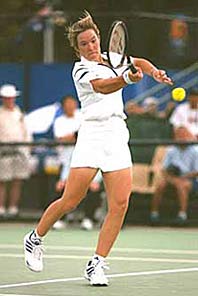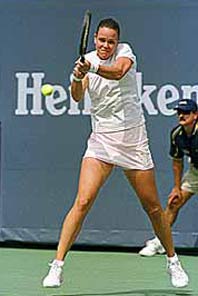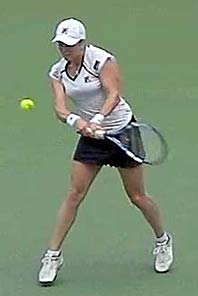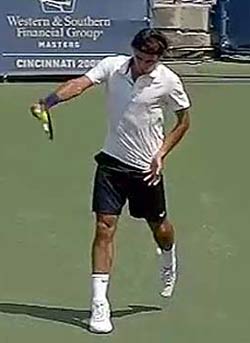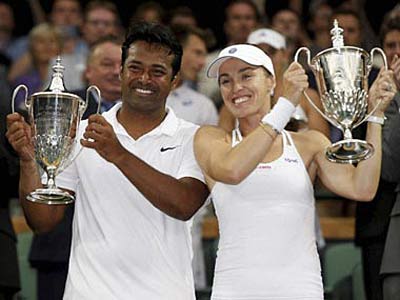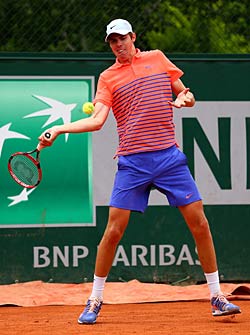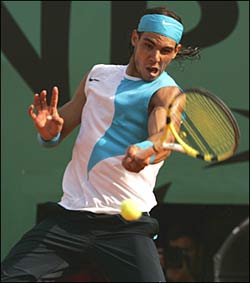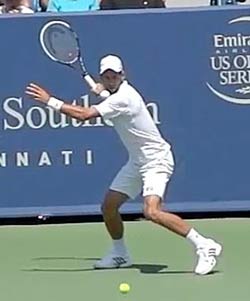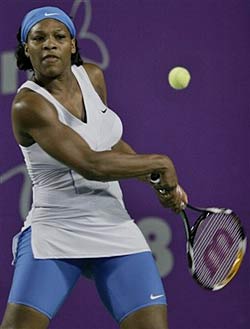|
TennisOne Lessons Thought-Provoking Ideas and Opinions about Wimbledon 2015 Paul Fein “Attack. Kill. Smile.” This is what Serena Williams wrote in her match notebook early in her career. At Wimbledon Serena did all that, especially the first two, as only she can. Sweeping aside a brutal draw, she kept alive her riveting campaign to achieve a rare Grand Slam. Novak Djokovic shrugged off the heartbreak of losing the French Open final and went on to win Wimbledon, his second major title of 2015 and ninth overall. Both superstars have clinched the No. 1 ranking this season but are hungry for much more. Here’s how I saw the Wimbledon that was and what it portends. The 'Greatest Ever' Debate Heats Up Serena Williams grabbed her sixth Wimbledon to increase her Grand Slam title haul to 21, three more than legends Martina Navratilova and Chris Evert and got within striking distance of Steffi Graf’s 22 and Margaret Court’s record 24. Comparing different eras is difficult, as now ESPN analyst Evert noted: “Martina Navratilova won 167 WTA events, I won [154], Serena’s won 67. You’ve got to put Martina and Steffi [Graf] [in the conversation for] greatest of all time. [Serena] at her best could beat any of the former champions just because it’s a better era in any sport. You’ve got better equipment, training techniques; it’s a whole new generation. But it’s impressive.” Fair enough. One could also argue that Graf’s career was aided by the tragic stabbing of archrival Monica Seles in 1993, and Court amassed 11 major titles at the Australian Open which had weak fields until the 1980s. On the other hand, while Serena competed in the 1999−2007 “Golden Era”—featuring her sister Venus, Justine Henin, Martina Hingis, Jennifer Capriati, Lindsay Davenport, Kim Clijsters, and Mary Pierce—her “elite” competition since then has diminished considerably. Where Serena stands in the pantheon should be settled in 2016 or 2017. What is indisputable, though, is that at her explosive best, Serena plays our sport better than anyone ever has. And as Tennis Channel analyst Mary Carillo said, “Even when she doesn’t play her best, she competes better than anyone on the planet.”
Who are the Greatest Athletes? During Wimbledon, ESPN analyst John McEnroe, a supremely athletic serve-volleyer in the 1980s, averred, “Three years ago, I thought she [Serena Williams] was the best to ever play, but it [this title] sort of cements it in historical terms. To me, she could arguably be the greatest athlete of the last 100 years.” McEnroe is right. Since tennis requires a greater range and degree of athletic abilities than all other women’s sports with the possible exception of basketball, Williams, Graf, and Navratilova rank as the top three athletes, in whatever order, in women’s sports history, or herstory.
And what about 17-time major winner and Wimbledon finalist Roger Federer? At nearly 34, he continues to dazzle us with jaw-dropping shot-making and athleticism. The Mighty Fed has far tougher competition than Serena because there are more men’s pro sports and leagues, and far fewer girls and women have participated in sports around the world since 1900. My all-time “greatest athlete” rankings put Federer at No. 5 behind Michael Jordan, Lebron James, Wayne Gretzky, and Willie Mays, and ahead of Pele, Muhammad Ali, Jim Brown, Michael Phelps, and Jim Thorpe. Changing of the Guard? For the first time in Wimbledon history, none of the ladies (Wimbledon doesn’t use the term “women”) singles quarterfinalists from the previous year made the quarterfinals this year. And for the sixth straight year Wimbledon has had at least one first-time ladies’ finalist. What does this mean? Pam Shriver, and other female TV analysts determined to put these shocking facts in a positive light, attributed this to the “great depth” in women’s tennis. However, an equally valid conclusion is that the top 10—which has a woeful combined career record of 7-72 against Serena—is quite weak and inconsistent. Alize Cornet upset Serena in 2014, but the biggest disappointments during the previous fortnight were unpredictable Petra Kvitova, the defending champion and second seed, who was upset by former No. 1 Jelena Jankovic, and defending finalist Eugenie Bouchard, who was stunned by virtual unknown Duan Ying-Ying of China in the first round. After a sensational breakthrough year, Bouchard is mired in a deep slump this season, losing 11 of her last 13 matches and plummeting to No. 26. Defending semifinalist and third-seeded Simona Halep also suffered a startling first-round loss to unheralded Jana Cepelova. Aside from highly impressive finalist Garbine Muguruza, the most promising arrivistes in the Elite Eight were two Americans: 20-year-old Madison Keys, the Australian Open semifinalist, and CoCo Vandeweghe, a cocky 23-year-old. Both boast big serves, but Keys possesses superior groundstrokes and fitness. “Keys keeps improving all the time,” says Navratilova. “For Madison, it’s all about harnessing her power and figuring out how much to use.” One wonders, though, who will fill the huge void in the post-Serena era. No young player stands out as a surefire future superstar. A Chain Is Only as Strong as Its Weakest Link One can heap superlatives on Roger Federer for everything from his dynamic, elegant game to his sporting demeanor, to his extraordinary record. Sometimes even the most astute experts get carried away. A case in point was former world No. 1 and current Tennis Channel analyst Jim Courier who asserted, “Federer’s backhand is a great shot, but it’s not as great as his forehand.”
After the final, ESPN analyst Darren Cahill nailed the truth when he pointed out: “We saw a lot of backhand shanks in Federer’s game. When Djokovic really needed a point, he homed in on Federer’s backhand.” The numbers bear out Cahill’s contention. Federer committed eight more unforced backhand errors than Djokovic (13 vs. 5), two more forced backhand errors (12 vs. 10), and three less backhand winners (1 vs. 4). Federer made one rallying and two serve return backhand errors in losing the first tiebreaker 7-1, and one serve return and three rallying errors in winning the second tiebreaker 12-10. The most troubling stat—which often plagues Federer—was converting only one of 7 break point opportunities. Most of these crucial break points occur in the ad court when opponents punish his vulnerable one-handed backhand with serves that pull him outside the alley. In sharp contrast, Djokovic possesses the greatest serve return in tennis history (sorry Agassi fans), and his backhand return is not just rock solid but often aggressive. Just imagine if Federer used a two-handed backhand. He might not slice and hit drop shots as well or draw raves for his beautiful game, but he likely would have captured even more Grand Slam titles. Age Is No Object How do 30-somethings not just survive, but even thrive, in a sport that requires terrific speed, strength, stamina, agility, and hand-eye and foot-eye coordination? After all, Bjorn Borg retired at 26, and McEnroe, Courier, Mats Wilander, and Boris Becker all declined by their early or mid-20s. Federer lost only one set (and dropping his serve just once) en route to the final, outclassing No. 3 Andy Murray, the 2013 Wimbledon champion, 7-5, 7-5, 6-4 in the semis. Not bad for the durable Swiss maestro who has played every major this century and turns 34 on August 8. After Serena won her eighth Miami title in April, she crowed, “I’d like to believe the older I get, the better I get.” Who could argue with that after she seized her fourth straight Grand Slam title and her eighth in the last 13 majors at the Big W? By stopping 21-year-old Muguruza 6-4, 6-4 in the final, Serena became the oldest woman to win a Grand Slam singles title at 33 years and 289 days, surpassing Navratilova by 26 days. (Navratilova won her last major title, the 2006 US Open mixed doubles title, with Bob Bryan at the almost unbelievable age of 49.) The secrets of their success? Roger and Serena are tremendously talented, of course, but they love to compete and are driven to do the hard yards in training.
And let’s not forget two more amazing “Golden Oldies.” Hingis won five singles and nine doubles Slam titles during her first career. Since then, the smiling Swiss who was named after Martina Navratilova, has retired and unretired twice and has been enshrined in the International Tennis Hall of Fame. Like Serena, Hingis is flourishing this year—as a 34-year-old doubles star. At Wimbledon she won both the doubles with India’s Sania Mirza and the mixed doubles with Leander Paes, also from India. Hingis and Paes trounced Timea Babos and Alexander Peya 6-1, 6-1 to win their second major mixed doubles title of the year together. The clever, skillful duo never faced a break point, and incredibly won almost three times as many points, 55 to 20, as their foes. Paes is no spring chicken, either; he’s a very young 42. Height and Muscles Make Might The average height of the pro players keeps increasing so the men’s locker rooms are starting to resemble those of NBA teams. The tallest tree in the forest, 6’11” Ivo Karlovic gained the Wimbledon round of 16, at age 36 no less, by winning three tiebreakers to upset Jo-Wilfried Tsonga. Kevin Anderson, at 6’8”, grabbed two tiebreakers to extend Djokovic to 7-5 in the fifth set, thus becoming the only foe to take two sets off the Serb. The 6’6” Marin Cilic and the 6’4” Vasek Pospisil gained the quarters.
American tennis may have a new tower of power to replace 6’10” John Isner, now 30, in 6’11” Reilly Opelka, the Wimbledon junior champion. In the semis, the unseeded Opelka whacked 18 aces (with no double faults) to topple world No. 1 Taylor Fritz 6-3, 7-6, a fellow American standing a mere 6’5”. Then Opelka blasted 15 aces (with two doubles faults) to beat Sweden’s Mikael Ymer 7-6, 6-4 for the title. Fortunately, Opelka, no one-trick pony, displayed a backhand and foot speed much superior to Isner’s. Three of the greatest champions in tennis history—Roger Federer, Rafael Nadal, and Pete Sampras—ar e 6’1”, and Djokovic is 6'2". Will they be the last superstars under 6’3”? Will tennis have its first 7’ champion in the 2020s? Muscles also make might, as 5’9 ½” Serena knows best, especially when she belts 120 mph-plus serves. Though she occasionally wears long sleeves to hide her bulging biceps in public, she has gradually learned to accept and to even be proud of her body type. Some women take a different view. Andrea Petkovic, a German ranked No. 14, revealed she cringes when she sees photos of her own muscular arms hitting two-handed backhands, viewing that body image as unfeminine. Still, many world-class players these days agree with former world No. 1 Caroline Wozniacki, who was featured in the Sports Illustrated swimsuit issue last year. “Right now I’m a tennis player, so I’m going to do everything I can to be the best tennis player that I can be,” Wozniacki told The New York Times. “If that means that I need to add a little muscle to my legs or my butt or whatever, then that’s what I’m going to do. I can be a model after I finish.” What's Wrong with Rafa? Tennis cognoscenti, and even Rafael Nadal himself, predicted that chronic knee problems caused by his grinding style would shorten his pro career that started at age 15 in 2002. For ten straight years, though, Nadal won at least one Grand Slam title, the last one coming at the 2014 French Open. With his 14 major titles, plus an Olympic gold medal, and two Davis Cup titles, some experts put him ahead of Federer as the GOAT. During Wimbledon, however, McEnroe reconsidered: “A year ago I was saying Rafael Nadal was the greatest player who ever lived. Now he looks like a shell of his old self. This has been an absolutely astounding decline.” After being upset by a player ranked No. 100 or lower for the fourth straight year at Wimbledon—this time to the flashy but erratic serve-and-volleyer Dustin Brown in the second round—a depressed Nadal confided: “Last year and this year, no problems at all with my knees. So I was ready to compete. I lost. I don’t know if I will be back to the level of 2008 or 2010 [when he won Wimbledon] or 2007 or 2006 or 2011 [when he was the Wimbledon runner-up].” During that press conference Nadal spoke in the past tense as if he sensed his best years were behind him.
Unlike Djokovic, whose game is extremely balanced and without any significant weakness, Nadal relies heavily on a powerful, vicious topspin forehand. His serve, while consistent and accurate, sometimes lacks power, and his backhand fluctuates in quality. In too many matches, though, including this Wimbledon, he retreats far behind the baseline to return serve and to rally defensively, forcing him to do more running than his opponents. Although the 29-year-old Spaniard enjoys winning career records against Federer (23-10), Djokovic (23-21), and Murray (15-6), Djokovic beat him in six of their last seven matches, including a 7-5, 6-3, 6-1 thrashing at the French Open. Equally disheartening, Murray, who had never beaten Nadal on clay before, stunned him 6-3, 6-2 in the Madrid final in May. At Wimbledon, Nadal often timidly under-hit or misfired his forehand, and he had no other weapons to compensate. Nevertheless, the resilient Rafa has rebounded from major injuries, extended inactivity, and worrisome slumps before. Even so, McEnroe suggested, “Nadal should no longer play the French Open and focus on the other majors.” To skip the major he’s won a record nine times would be ridiculous.McEnroe also urged Nadal to "Get a new damn coach … to bring a new voice in." Firing Uncle Toni, who has guided Rafa since he was four years old, could disorient the sensitive and habit-addicted Nadal. But adding another coach or consultant to Team Nadal, as Federer and Djokovic did in hiring former champions Becker and Stefan Edberg, might work. If Nadal fares poorly at the US Open and during tournaments next year and seldom shouts “Vamos!” or pumps his fist after a terrific shot, he may become the first of the celebrated “Big Four” to retire. That would be an incalculable loss for tennis. Did You Know? Here are some revealing and perhaps surprising stats and facts. Djokovic is the only man to beat both Federer and Nadal, the consensus two greatest tennis players ever, at each of the four majors. Serena has won eight major titles since turning 30, a record, and those eight came in the 13 majors since she hired Patrick Mouratoglou as coach. “Patrick Mouratoglou has been the best thing that ever happened to Serena Williams,” said ESPN analyst Pam Shriver. Federer’s awesome performance against Murray can be summed up by two stats: 56 winners versus only 11 unforced errors. Djokovic was almost as impressive against Federer, blasting 46 winners against just 16 unforced errors. In the pivotal third set of the final, Djokovic hit 47% of his groundstrokes from inside the baseline, compared to just 29% for the first two sets. Position matters—a lot. For clutch serving to wrap up sets and matches, no player since Pete Sampras can match Serena. In her 17-ace, high-caliber 3-6, 6-2, 6-3 victory over Victoria Azarenka, Serena whacked three aces in each of her last two service games. Serena topped even that in the final game of her 6-2, 6-4 semifinal victory over Maria Sharapova. The Russian contacted the ball just once in five points. Serena banged three aces, a double fault, and a service winner that ricocheted off Sharapova’s racket. As former No. 1 Davenport said, “The way she brings out her serve when she needs it is something we’ve never seen before.” In Praise of Novak Djokovic
With a complete and balanced game featuring terrific technique, controlled aggression, speed, and stamina, Djokovic unsurprisingly has reached 15 of the last 20 Grand Slam finals. He seldom suffers bad losses because his lowest playing level is still quite high, unlike that of Nadal, Murray, and even Federer. True, he can’t produce sublime Federeresque A+ tennis at his peak, but he can sustain A and A- tennis longer than anyone. Now if he could only lob better—he rarely lofted them past the service line against Federer—and put overheads away with more authority, he’d be pretty close to perfect. The Djoker sure knows how to relax during tournaments and have fun after them. At the Big W, he occasionally meditated at a nearby Buddhist temple. At the annual Champions' Dinner, he and Serena Williams revived an old Wimbledon tradition by hitting the dance floor together. They got the party rocking by delivering their interpretation of the Bee Gees tune “Night Fever.” Djokovic, who owns nine major titles, has a good shot at equaling, or even surpassing Nadal’s 14. Federer’s record of 17 could prove a road too far. But the versatile Serb now enters every Grand Slam tournament as the favorite because he excels on every surface. Only if Nadal pulls another strong comeback, would that favorite status change at Roland Garros. Best-case scenario for Djokovic: he captures the US Open in September and then wins two or three majors in each of the next two years. Groomed to be a champion since he was a little boy, Djokovic is unabashedly ambitious. “I’m 28. I feel good. I don’t feel old. I have hopefully many more years in front of me,” he said. “I’m going to try to push my own limits and see how far I can go really with titles and with myself playing on this high level.” The Big Story Forget the so-called “Serena Slam.” She won four straight majors in 2002−2003 and then again in 2014−2015 which she completed by capturing Wimbledon. However, the only true and legitimate “Slam” is the actual Grand Slam—winning all four majors in a calendar year. The same goes for the Grand Slam in golf and the coveted Triple Crown in baseball. You have to pull them all off in the same year. That’s what makes all these feats so difficult, rare, and historic. Not to mention so hyped by the media and pressure-packed for the athletes. Even the Great Ones feel the pressure. Serena uncharacteristically started the ladies’ final against Muguruza by double faulting thrice in the opening game to lose her serve. “I’ve never known a champion to be off her game so much at times,” Evert said when Serena tightened up again and got broken again in the penultimate game. “Her lows are lower than most champions. But, boy, her highs are higher. She’s setting some big records, [so] remember it’s totally understandable.”
The stakes could not be higher at the US Open. How will Serena deal with the immense pressure to complete the first Grand Slam since Graf’s in 1988—as well as tie Graf’s Open Era record of 22 majors? Will she suffer a mental meltdown? At the 2009 Open, when called for a foot fault, she exploded, and brandishing her racket, cursed and threatened a lineswoman. At the 2011 Open, just as her two-year probation was expiring, she repeated her disgraceful tirade when she was upset by Samantha Stosur in the final. The combustible Serena verbally abused the chair umpire who had penalized her a point for yelling “Come on!”—which violated the hindrance rule—as Stosur was about to hit the ball. Or will the more mature Serena conquer her demons and seven opponents at Flushing Meadows? “It’s her American championships. It would be so appropriate for this to end at the US Open,” said Evert. “Serena feeds on the crowds and their enthusiasm. You know the crowds will be behind her every single match. It’s just going to be a wild scene at the US Open.” When asked whether her strength was more mental or physical, Serena quickly replied, “Mental.” It will have to be if the most volatile and polarizing champion since McEnroe falters or faces some New York crowds even tougher than her opponents. And if Serena reaches the final, her Grand Slam quest could climax with the Match of the Century. * * * * * Your comments are welcome. Let us know what you think about Paul Fein's article by emailing us here at TennisOne.
Paul Fein Paul Fein has received more than 30 writing awards and authored three books, Tennis Confidential: Today’s Greatest Players, Matches, and Controversies, You Can Quote Me on That: Greatest Tennis Quips, Insights, and Zingers, and Tennis Confidential II: More of Today’s Greatest Players, Matches, and Controversies. Fein is also a USPTA-certified teaching pro and coach with a Pro-1 rating, former director of the Springfield (Mass.) Satellite Tournament, a former top 10-ranked men’s open New England tournament player, and currently a No. 1-ranked Super Senior player in New England. |
